As gardeners, we nurture our plants with dedication, watering, weeding, fertilizing, and admiring them as they grow. But when the first frost of the season hits, all that hard work can be undone overnight. Frost is often called the “silent killer” because it creeps in unexpectedly, covering plants with a delicate white sheen that may look beautiful but can destroy tender crops in hours.
The good news? With preparation and the right protection strategies, you don’t have to let frost claim your garden. This guide will take you step-by-step through understanding frost, identifying vulnerable plants, and applying both DIY and advanced solutions to ensure your garden thrives through the cold.
🌡️ 1. What Exactly Is Frost?

Frost forms when air temperatures drop to 32°F (0°C) or lower, causing water vapor to freeze on surfaces like leaves, stems, and soil. When ice crystals form inside plant cells, they rupture the delicate tissues, leading to wilted, blackened, or dead plants.
There are different types of frost:
-
Hoar Frost: A light, sparkling frost that coats surfaces.
-
Black Frost: Occurs without visible ice, leaving plants limp and damaged.
-
Radiation Frost: The most common in gardens, caused by clear skies and calm winds that allow heat to escape.
👉 Knowing the type of frost helps you better predict damage and choose the right defense.
📅 2. Know Your First and Last Frost Dates

Every gardening zone has a “frost window.” By looking up your USDA Plant Hardiness Zone or checking with a local extension office, you can find the average first frost (fall) and last frost (spring) for your region.
Why this matters:
-
Planting schedules: Avoid sowing frost-sensitive crops too early.
-
Harvest timing: Gather tender crops before frost arrives.
-
Protection planning: Have row covers, mulches, and blankets ready before the danger begins.
👉 Example: In Zone 6, the average first frost is mid-October, and the last frost is mid-April. That’s nearly 6 months where frost protection strategies are essential.
🥦 3. Identifying Frost-Hardy vs. Frost-Tender Plants
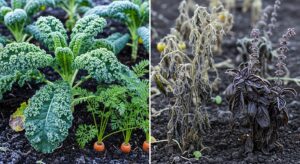
Not all plants react the same way to cold. Some thrive in it, while others collapse at the first touch of frost.
Frost-Hardy Plants (can tolerate below 32°F):
-
Kale, spinach, collard greens
-
Carrots, beets, parsnips
-
Garlic, onions, and leeks
-
Broccoli, cabbage, Brussels sprouts
Frost-Tender Plants (require protection):
-
Tomatoes, peppers, eggplant
-
Squash, zucchini, cucumbers
-
Basil, dill, and other soft herbs
-
Melons, beans, okra
👉 Knowing which category your plants fall into helps you decide where to focus your frost protection efforts.
🏡 4. Mulch: The Blanket for Your Garden
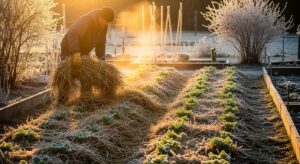
Mulching is one of the simplest yet most effective frost-protection strategies.
How it works: Mulch acts as an insulator, trapping heat in the soil and keeping root zones warmer.
Best mulch choices for frost:
-
Straw or hay (thick layer, 4–6 inches).
-
Shredded leaves (free and effective).
-
Pine needles (great for acidic-soil crops like blueberries).
-
Wood chips (longer-lasting for perennials).
👉 For root crops like carrots and beets, a heavy mulch layer means you can “store” them in the ground all winter and harvest as needed.
🌿 5. Row Covers, Tunnels, and Blankets
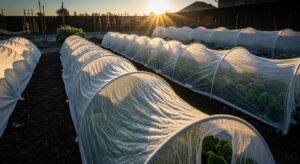
When frost looms, physical barriers are lifesavers.
-
Row Covers: Lightweight fabrics (like Agribon) allow light and water through but block frost.
-
Plastic Tunnels: Hoop houses covered in clear plastic create mini-greenhouses.
-
Frost Blankets: Old sheets, quilts, or burlap can be draped over plants during cold nights.
👉 Pro Tip: Ensure covers don’t touch the plants directly, as frost can transfer through contact. Use stakes or hoops to create space.
💧 6. Watering Before Frost – Why It Works

It might sound strange, but watering your soil before a frost helps protect your plants.
-
Moist soil absorbs and holds more heat than dry soil.
-
Overnight, it releases warmth slowly, buffering roots against freezing.
-
Avoid overwatering soggy soil can suffocate roots.
👉 Tip: Water during the day when temperatures are above freezing, not at night.
🌲 7. Windbreaks: Fighting Frost and Cold Winds
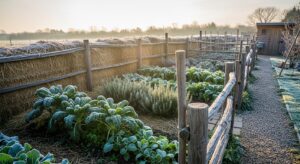
Frost damage worsens when paired with biting winds. Installing barriers helps trap heat and reduce exposure.
Options include:
-
Hedges or shrubs along the edges of your garden.
-
Straw bales or wooden fencing.
-
Temporary fabric screens on stakes.
👉 Even a simple windbreak can raise the temperature by a few degrees—sometimes enough to save crops.
🌸 8. Harvesting Before Frost Hits

If frost is imminent, sometimes the best protection is to harvest ahead of time.
-
Pick tomatoes (even green ones they ripen indoors).
-
Cut herbs like basil and parsley for drying or freezing.
-
Gather cucumbers, squash, and peppers before they turn mushy overnight.
👉 Better to harvest slightly early than to lose the entire crop.
🌞 9. Season-Extending Tools: Cold Frames & Greenhouses

For serious gardeners, extending the growing season is the ultimate frost defense.
-
Cold Frames: Wooden or brick boxes with glass tops. Perfect for lettuce, spinach, and radishes in fall and early winter.
-
Greenhouses: From small walk-ins to large structures, they protect sensitive crops while allowing year-round growing.
👉 These tools not only fight frost but also help with early spring planting.
🔄 10. Crop Rotation and Soil Health in Cold Seasons

Healthy soil = stronger plants = better frost resistance.
-
Rotate crops each year to prevent nutrient depletion.
-
Use cover crops (clover, rye, or vetch) in fall to enrich the soil and prevent erosion.
-
Add compost in late fall to feed the soil over winter.
👉 Strong root systems developed in healthy soil withstand cold far better.
🛠️ 11. DIY Frost Protection Hacks
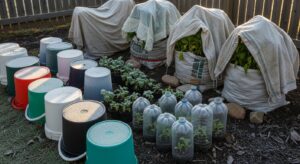
Not everyone has fancy frost blankets but you don’t need them.
-
Buckets or Milk Jugs: Invert over small plants at night.
-
Plastic Bottles: Cut in half to make mini cloches.
-
Holiday Lights: String non-LED lights under covers for gentle warmth.
-
Upside-down Baskets: Quick plant protectors for small crops.
👉 The key is quick thinking many household items double as frost shields.
🌼 12. Planning a Frost-Resilient Garden

Think long-term:
-
Plant perennials and shrubs that naturally protect smaller plants.
-
Use raised beds they warm faster in spring and drain better in fall.
-
Design your garden with sun patterns, wind directions, and frost pockets in mind.
👉 With planning, your garden becomes less vulnerable to killer frost year after year.
🌿 Final Thoughts
“Killer frost” may sound terrifying, but it doesn’t have to spell disaster for your garden. By understanding frost, identifying vulnerable plants, and using a mix of preventive strategies and quick fixes, you can outsmart the cold and enjoy a longer, more fruitful growing season.
Whether it’s mulch, row covers, or creative DIY hacks, the key is preparation. The earlier you act, the more resilient your garden becomes—so when frost arrives, you’ll be ready.
🌱 10 FAQs on Frost Protection in Gardening
1. What temperature is considered a killing frost?
A killing frost usually occurs when temperatures drop below 28°F (-2°C) for several hours, damaging or killing tender plants.
2. How can I tell if frost is coming?
Watch for clear skies, calm winds, and rapid nighttime cooling—these are signs frost is likely. Local frost forecasts are also very reliable.
3. Which plants are most vulnerable to frost?
Tender crops like tomatoes, peppers, basil, cucumbers, and melons are highly sensitive, while kale, cabbage, carrots, and garlic can withstand light frost.
4. Is it better to water my plants before or after frost?
Always water soil before frost (not after). Moist soil retains heat better, helping protect roots and lower plant temperatures less drastically.
5. Do raised beds freeze faster than ground soil?
Yes, raised beds lose heat more quickly. Protect crops in raised beds with extra mulch or row covers during frost nights.
6. What are the best quick fixes for unexpected frost?
Buckets, old sheets, cardboard boxes, and plastic containers can be placed over plants as emergency protection. Just remove them once the sun rises.
7. Can mulch alone protect plants from frost?
Mulch helps regulate soil temperature and shields roots, but above-ground parts of tender plants may still need covers during hard frosts.
8. Do I need a greenhouse to protect my garden from frost?
Not necessarily. Cold frames, row covers, and DIY tunnels can provide plenty of frost protection for small gardens without the cost of a full greenhouse.
9. Should I harvest all my crops before frost?
Harvest tender crops (like tomatoes and peppers) before frost. Cold-tolerant crops (like kale, spinach, and carrots) can stay in the ground longer.
10. How can I plan a frost-resilient garden for next year?
Choose frost-hardy plants, plant according to frost dates, integrate windbreaks, and consider raised beds or cold frames for better long-term protection.